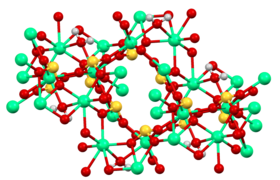Calcium sulfite

| |
| Names | |
|---|---|
| IUPAC name
Calcium sulfite
| |
Other names
| |
| Identifiers | |
| |
3D model (
JSmol ) |
|
| ChemSpider | |
ECHA InfoCard
|
100.030.529 |
| EC Number |
|
| E number | E226 (preservatives) |
PubChem CID
|
|
| UNII | |
CompTox Dashboard (EPA)
|
|
| |
| |
| Properties | |
| CaSO3 | |
| Molar mass | 120.17 g/mol |
| Appearance | White solid |
| Melting point | 600 °C (1,112 °F; 873 K) |
| 4.3 mg/100 mL (18 °C) | |
Solubility product (Ksp)
|
3.1×10−7[1] |
| Hazards | |
| Flash point | Non-flammable |
| Related compounds | |
Other anions
|
Calcium sulfate |
Other cations
|
Sodium sulfite |
Except where otherwise noted, data are given for materials in their standard state (at 25 °C [77 °F], 100 kPa).
| |
Calcium sulfite, or calcium sulphite, is a chemical compound, the
Production
It is produced on a large scale by flue gas
Scrubbing with limestone follows the following idealized reaction:
- SO2 + CaCO3 → CaSO3 + CO2
Scrubbing with hydrated lime follows the following idealized reaction:[4][5]
- SO2 + Ca(OH)2 → CaSO3 + H2O
The resulting calcium sulfite oxidizes in air to give gypsum:
- CaSO3 + 1⁄2 O2 → CaSO4
The gypsum, if sufficiently pure, is marketable as a building material.
Uses
Drywall
Calcium sulfite is generated as the intermediate in the production of gypsum, which is the main component of drywall. A typical US home contains 7 metric tons of such drywall gypsum board.[6]
Food additive
As a food additive it is used as a preservative under the E number E226. Along with other antioxidant sulfites, it is commonly used in preserving wine, cider, fruit juice, canned fruit and vegetables. Sulfites are strong reducers in solution, they act as oxygen scavenger antioxidants to preserve food, but labeling is required as some individuals might be hypersensitive.
Wood pulp production
Chemical wood pulping is the removal of cellulose from wood by dissolving the lignin that binds the cellulose together. Calcium sulfite can be used in the production of wood pulp through the
Gypsum
There is a possibility to use calcium sulfite to produce gypsum by oxidizing (adding O2) it in water mixture with the manganese (Mn2+) cation or sulfuric acid catalyzers.[7][8]
Structure
-
Structure of the [Ca3(SO3)2(H2O)12]2+ cage in calcium sulfite tetrahydrate.
-
Structure of anhydrous CaSO3.
X-ray crystallography shows that anhydrous calcium sulfite has a complicated polymeric structure.[9] The tetrahydrate crystallizes as a solid solution of Ca3(SO3)2(SO4).12H2O and Ca3(SO3)2(SO3).12H2O. The mixed sulfite-sulfate represents an intermediate in the oxidation of the sulfite to the sulfate, as is practiced in the production of gypsum. This solid solution consists of [Ca3(SO3)2(H2O)12]2+ cations and either sulfite or sulfate as the anion.[2][10] These crystallographic studies confirm that sulfite anion adopts a pyramidal geometry.
Natural occurrence
Calcium sulfite(III) hemihydrate occurs in the nature as the rare mineral hannebachite.[11][12]
See also
References
- ISBN 978-1138561632.
- ^ .
- ISBN 978-3527306732.
- ^ Hudson, JL (1980). Sulfur Oxidation in Scrubber Systems. University of Virginia.
- ^ Miller, Bruce (2004). Coal Energy Systems. Elsevier Science Technology. pp. 294–299.
- ^ "USGS Gypsum Statistics and Information". USGS. Retrieved June 26, 2016.
- S2CID 98774317.
- ^ "How can we convert calcium sulfite into calcium sulfate after..." ResearchGate. Retrieved 2018-05-18.
- ^ Yasue, Tamotsu; Arai, Yasuo (1986). "Crystal Structure of Calcium Sulfite". Gypsum & Lime (Jap. Language). 203: 235–44.
- .
- ^ "Hannebachite".
- ^ "List of Minerals". 21 March 2011.

![Structure of the [Ca3(SO3)2(H2O)12]2+ cage in calcium sulfite tetrahydrate.](http://upload.wikimedia.org/wikipedia/commons/thumb/3/35/Ca3%28SO3%292aq12.png/180px-Ca3%28SO3%292aq12.png)
